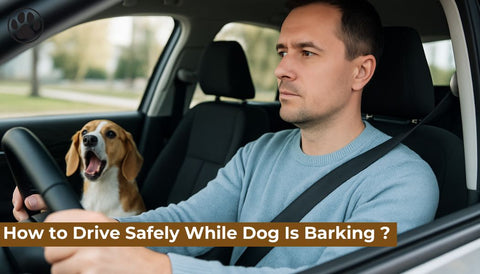
How to Tell If a Dog is Cold ?
of reading - words
As temperatures drop, many pet owners wonder if their dog is cold and whether they need extra protection. Unlike humans, dogs can't verbally express discomfort, so it's essential to recognize the signs of cold weather distress. Understanding how dogs react to cold, their tolerance levels, and how to keep them warm is crucial for their health and well-being.
Why Do Dogs Get Cold?
Although dogs have fur, it doesn’t always provide sufficient warmth, especially in freezing temperatures. Factors influencing a dog's sensitivity to cold include:
-
Breed and Coat Type: Short-haired or small breeds like Chihuahuas are more vulnerable to cold than thick-coated breeds like Huskies.
-
Age and Health: Puppies, senior dogs, and those with medical conditions are more susceptible to cold.
-
Size and Body Fat: Smaller dogs lose heat faster than larger, well-insulated breeds.
-
Acclimation: Dogs used to warmer climates struggle more in cold weather than those adapted to it.
Signs That Your Dog Is Cold
1. Shivering or Trembling
If your dog is shivering or trembling, it’s a clear indicator that they are cold. This involuntary reaction helps generate body heat, but persistent shivering means they need warmth immediately.
2. Whining or Seeking Shelter
Dogs that feel cold may whine, whimper, or try to find a warm place. If your dog attempts to burrow under blankets or press against heat sources, they might be feeling too cold.
3. Cold Ears and Paws
Check your dog's ears and paws. If they feel unusually cold to the touch, your dog is losing heat and could be at risk of hypothermia.
4. Curling Up Into a Ball
Dogs instinctively curl up to conserve heat, much like they would in the wild. If you notice your dog in a tight ball for extended periods, they might be too cold.
5. Sluggish or Lethargic Behavior
A cold dog may show low energy levels and reluctance to move. If your usually energetic dog suddenly appears slow or tired in cold weather, it may be struggling to maintain body temperature.
6. Lifting Paws Off the Ground
Dogs may lift their paws when walking on cold surfaces. Ice, snow, or freezing pavements can make their paws uncomfortable, signaling that they need protection like dog booties.
7. Reluctance to Go Outside
If your dog resists going outside or quickly wants to come back in, they could be uncomfortable in the cold.
8. Ice or Snow Sticking to Fur
Some breeds, especially those with longer fur, can accumulate ice or snow on their fur and paws. This can make them even colder and should be removed promptly.
9. Slow or Shallow Breathing
Extreme cold can slow down a dog’s respiration, leading to shallow or irregular breathing, a potential sign of hypothermia.
How to Keep Your Dog Warm
1. Provide Warm Shelter
If your dog spends time outside, ensure they have a warm, insulated shelter. A doghouse with blankets or heated pads can help maintain warmth.
2. Dress Them in Dog Coats or Sweaters
Certain breeds, especially short-haired ones, benefit from wearing dog sweaters or coats. These add an extra layer of warmth, especially during outdoor walks.
3. Use Booties to Protect Their Paws
Booties help shield paws from ice, salt, and freezing surfaces. If your dog refuses booties, try applying a paw balm to prevent cracking.
4. Limit Outdoor Time in Extreme Cold
Reduce your dog’s exposure to cold temperatures. Shorter, more frequent walks are better than extended periods in freezing weather.
5. Offer a Cozy Bed and Blankets
Make sure your dog has a warm bed, preferably elevated from cold floors, with plenty of blankets to snuggle into.
6. Adjust Their Diet
Dogs may need extra calories in colder months to help generate warmth. Consult your vet before making changes to their diet.
7. Keep Them Dry
A wet coat makes it harder for dogs to stay warm. Dry them off thoroughly if they get wet from rain or snow.
When to See a Vet
If your dog shows severe signs of hypothermia, such as weak pulse, extreme lethargy, confusion, or collapse, seek veterinary attention immediately.
Frequently Asked Questions (FAQ)
1. What temperature is too cold for dogs? It depends on the breed, but temperatures below 45°F (7°C) can be uncomfortable for some dogs, while temperatures below 32°F (0°C) can be dangerous for many.
2. Can dogs get hypothermia? Yes, prolonged exposure to cold can lead to hypothermia, which is life-threatening. Symptoms include shivering, lethargy, and slowed breathing.
3. Do dogs need jackets in the winter? Short-haired, small, or senior dogs benefit from jackets, especially in freezing temperatures.
4. How can I tell if my dog is warm enough? If your dog is relaxed, breathing normally, and not shivering, they are likely warm enough. Check their ears and paws to ensure they aren’t too cold.
5. Should I let my dog sleep under a blanket? Yes, as long as your dog can easily move and doesn’t overheat, it’s safe to let them sleep under a blanket for warmth.
Conclusion
Understanding the signs that a dog is cold helps keep your furry friend comfortable and safe during colder months. By providing proper shelter, clothing, and monitoring their behavior, you can ensure your pet stays warm and healthy all winter long. Always prioritize your dog's well-being and consult a veterinarian if you suspect they are experiencing severe cold distress.




